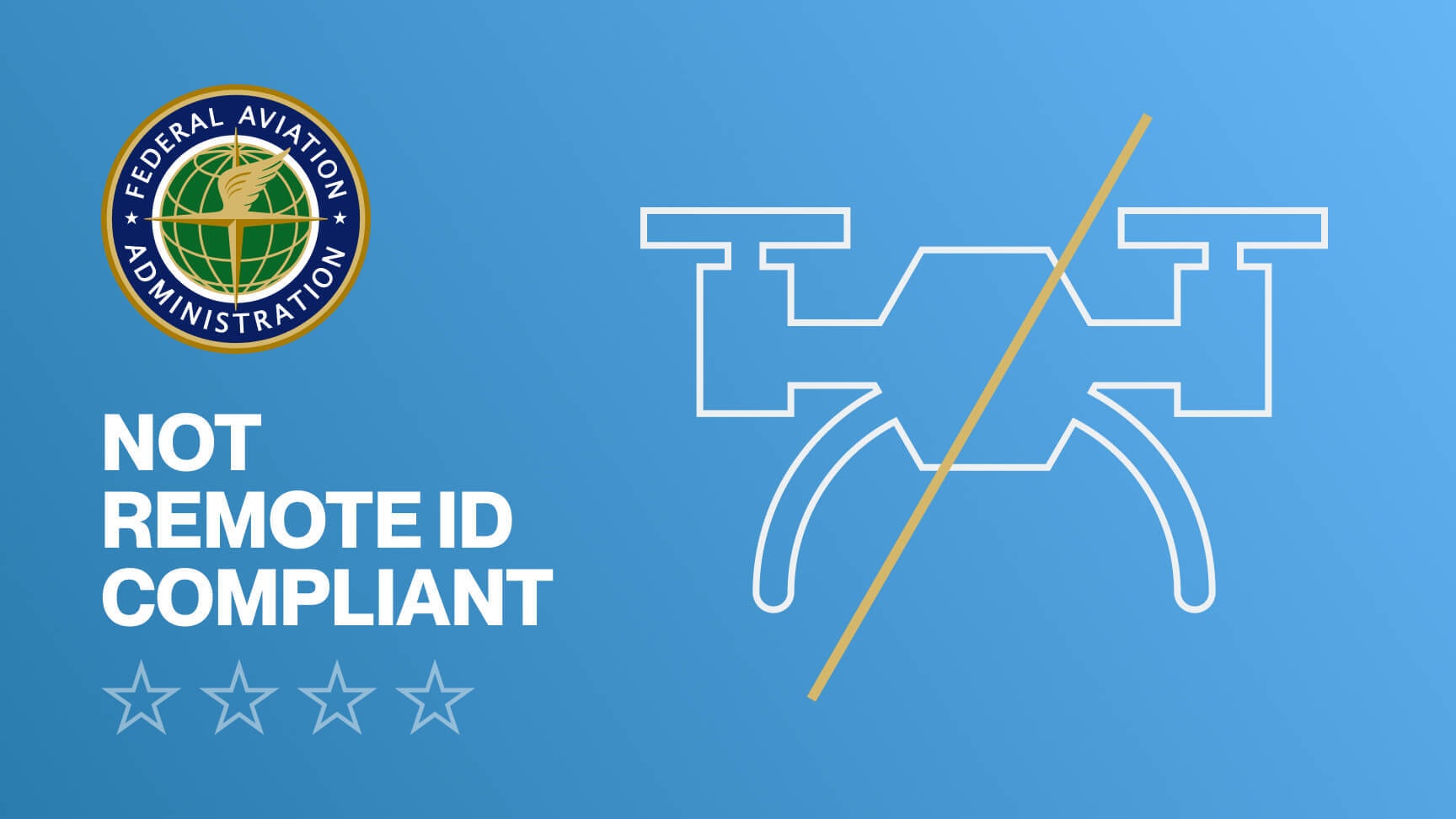
Drone Manufacturers Fail FAA Remote ID Requirements
March 13th, 2024Drone Remote ID Requirements
The FAA's requirement surrounding real-time broadcast of identifying and positional information on sUAS has had a bumpy start, including privacy concerns from the community, supply chain challenges leading to extensions, and a lack of infrastructure support. With the March 16 compliance deadline looming, pilots will soon be held accountable and may face hefty fines and/or suspension or revocation of pilot certificates if flying aircraft that do not meet the standard's specifications.
As a brief summary, Remote ID is often likened to a digital license plate in that it can provide a means for public safety officials and authorized officials to identify the owner of a sUAS if flying in an unsafe manner or in a restricted area. Pilots can comply with the requirement by either using a Remote ID module or by operating a standard Remote ID drone. The former is a physical device that can attach to the aircraft and broadcast the necessary information, and the latter implies that the manufacturer has taken responsibility for implementing broadcast of the required information, typically via a firmware update to the drone.
According to the FAA, more than 1 million drones are registered in the United States today, with nearly 3.5 million total drones currently in use. The global commercial drone market will reach $58.4 billion in 2026. Growth at this pace necessitates the ability for authorities to differentiate authorized drones from those that may pose a threat.
Overview of Findings
SkySafe set out to analyze the implementation details of standard Remote ID drones across major drone manufacturers and was shocked to find that many fell far short of the required specifications outlined in ASTM F3411 - 22a, "Standard Specification for Remote ID and Tracking", raising concerns and questions about accountability. Expectations were tempered given that compliance is based on an honor system of self-certification, but the team was still surprised by their results; while some manufacturers followed the implementation perfectly, others ranged from perplexing to outright disastrous and, in one case, claims of support are being made where no such support exists. The following sections contain the highlights—and lowlights—for several drone manufacturers.
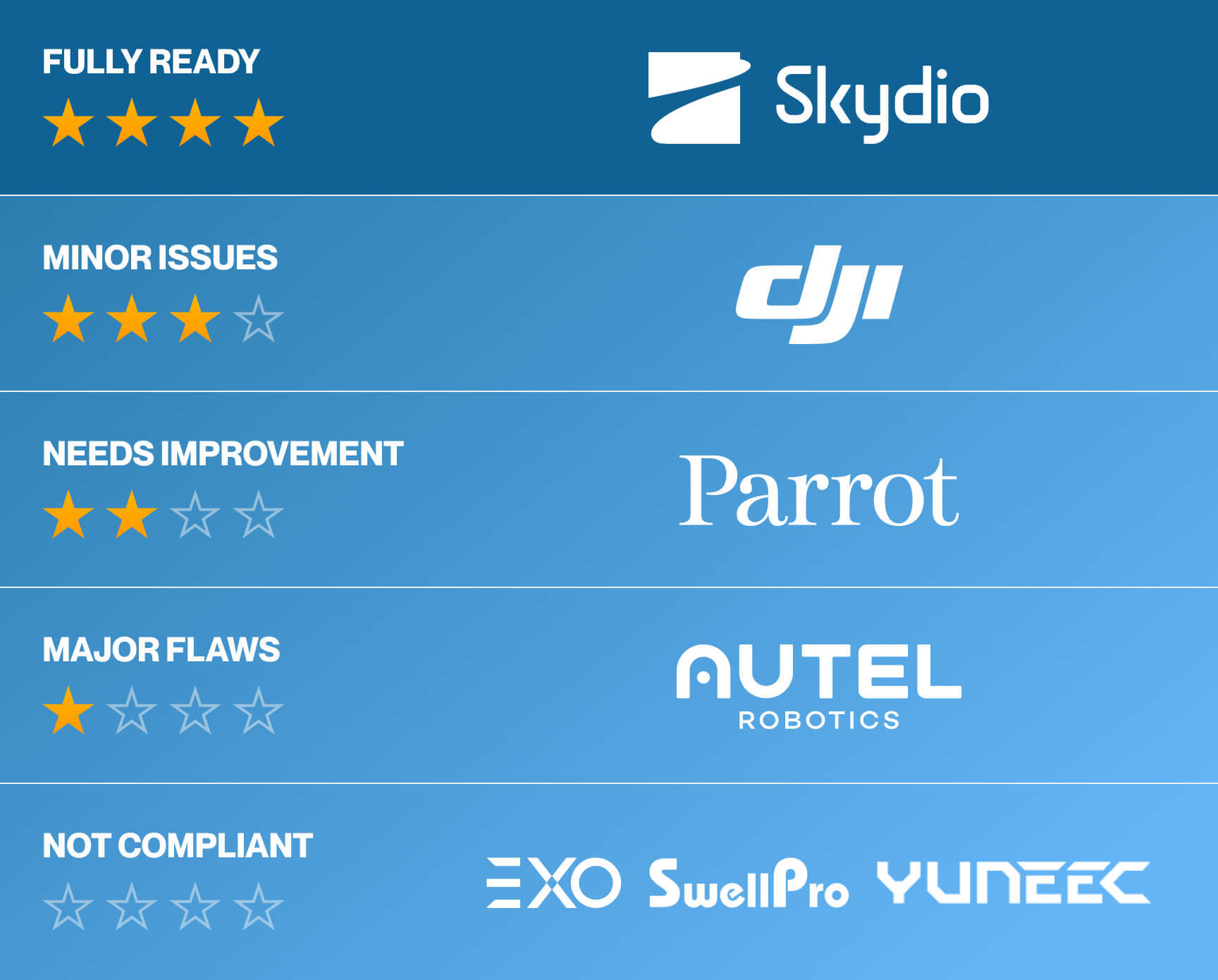
How We Tested
The SkySafe team focused on diving into deep analysis of the various services and components responsible for implementing Remote ID within each platform. We performed several data collection tests within a controlled environment in order to ensure the data format matched what was expected based on our research, and then compared this data to Remote ID broadcasts received across SkySafe One, our national drone tracking sensor network. Finally, the team compared this data against the specifications outlined in ASTM F3411 to make the determination of compliance.
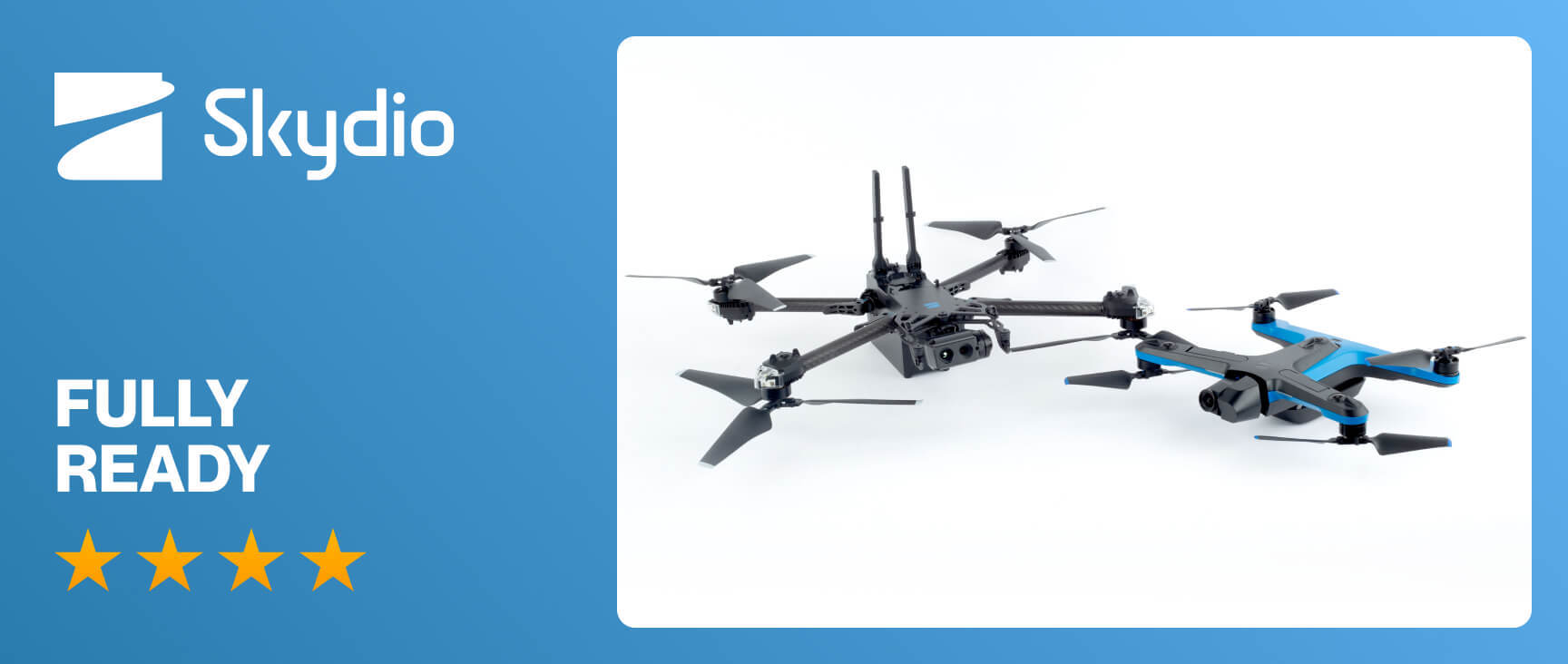
Skydio: Fully Ready
American drone company, Skydio, implemented WiFi Beacon-based broadcasts for their standard Remote ID drones, which include all current models in their fleet. SkySafe found Skydio's implementation to be excellent; Skydio drones use compliant serial numbers and offer no user-exposed method of disabling Remote ID broadcasts in their mobile app.
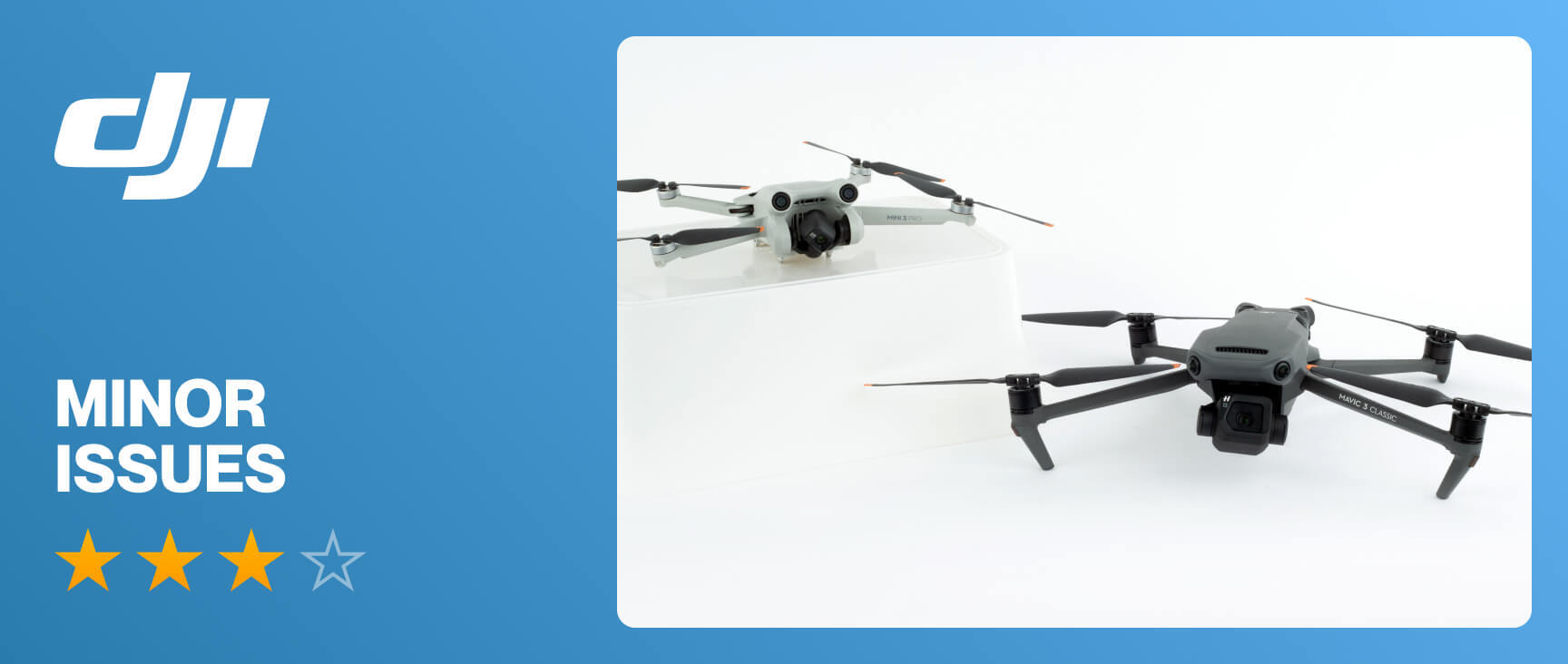
DJI: Minor Issues
Market-leader DJI implemented WiFi Beacon-based Remote ID broadcasts in their standard Remote ID drones. The implementation is relatively robust except for inconsistent use of home vs. app location and inconsistent use of altitude standards (HAE vs. MSL). These inconsistencies vary based on firmware versions, leading to varied and unpredictable drone reporting.
In a strange twist that was announced in early February of this year, the DJI Mini 3 and Mini 4 Pro models stopped transmitting Remote ID entirely in their default configuration. This change renders these drones non-compliant with standard Remote ID requirements when operating in this default mode, which is active when the aircraft is flying with standard batteries.
The weight of standard batteries keeps the drone's total weight under 250g, which means this won't cause any issues for a recreational flier, but it will lead to non-compliance for any Part 107 pilot using this configuration.
Part 107 pilots in this situation will have two options for achieving compliance: they can opt to upgrade from standard batteries to Intelligent Flight Battery Plus, as this puts the weight of the aircraft over 250g, triggering the standard Remote ID activation in the drone. Additionally, they could continue using standard batteries and attach a Remote ID broadcast module to the drone.
DJI responded that the Declaration of Compliance (DoC) was always configuration-specific for these drones, and only ever included those used with Intelligent Flight Battery Plus. The potential issue here that may in fact lead to non-compliance is found in Section 12.2 of ASTM F3411 - 22a, Standard Specification for Remote ID and Tracking, which states:
12.2 UAS that Are Marked:
12.2.1 "ASTM F3411-22a-RID-N" compliant must comply with the Network Remote ID standard.
12.2.2 "ASTM F3411-22a-RID-B" compliant must comply with the Broadcast Remote ID standard.
Thus any DJI Mini 3 and DJI Mini 4 Pro drones marked as Remote ID and Tracking capable must comply with the standard and broadcast this information. Turning it off in any configuration would be in violation of the FAA's compliance standard.
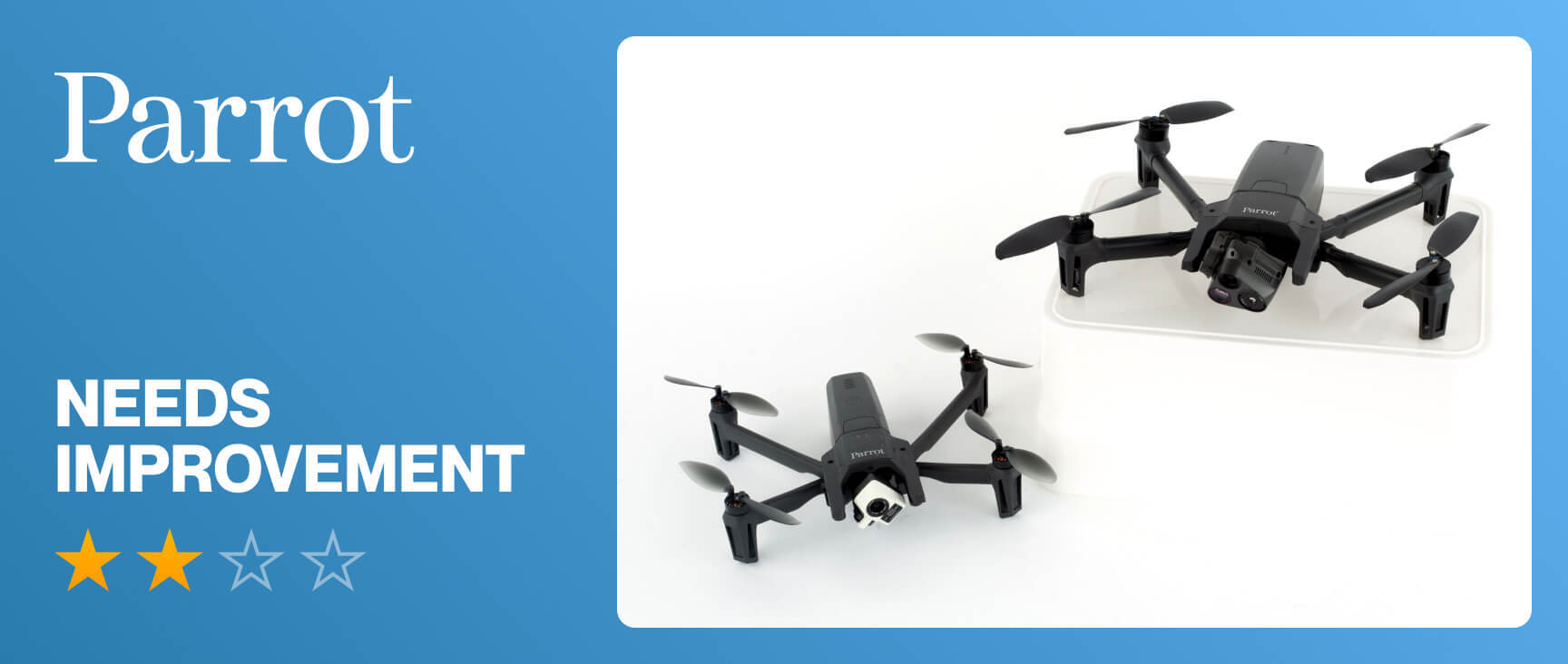
Parrot: Needs Improvement
Like most of the drones SkySafe looked at, Parrot uses WiFi Beacon-based Remote ID broadcasts. Their implementation is based on the legacy French DRI standard, so older drones broadcast non-compliant ASTM identifiers. Pulling nationwide data from the SkySafe One™ sensor network over the past 30 days, the team found that 43% of Parrot drones broadcasting Remote ID data had non-compliant identifiers, all starting with the prefix PI040 instead of the FAA-approved 1588E prefix in the DoC.
SkySafe also found that Remote ID is configurable/mutable in the mobile app on some older models, which gives pilots the option of disabling Remote ID broadcasts on drones that are supposed to be standard Remote ID drones.
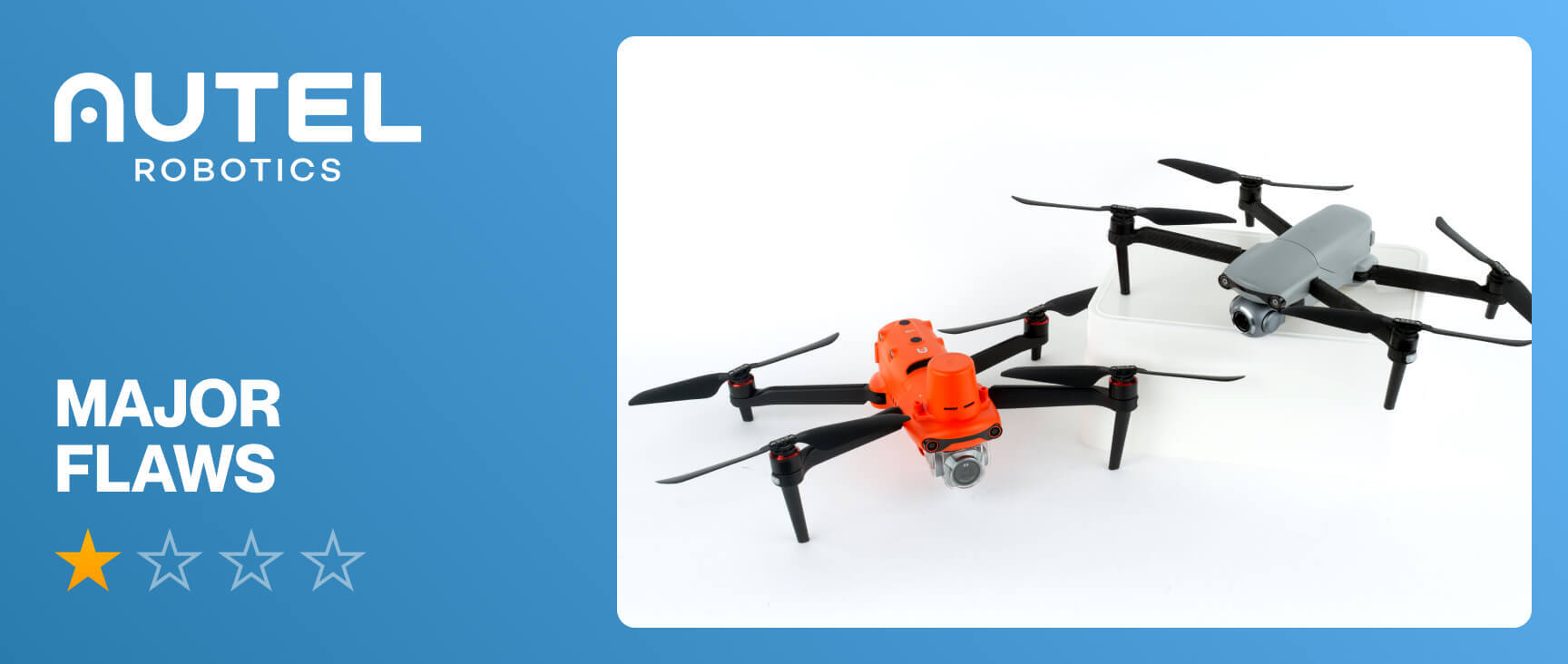
Autel: Major Flaws
Autel's implementation of the Remote ID standard is the most broken seen to date in SkySafe's research. While Autel initially started rolling out pieces of a WiFi NaN implementation in their firmware early on, it appears that they decided not to use this implementation and opted instead for misconfigured WiFi Beacons featuring a fixed MAC address across all drones and an SSID of "default-ssid."
SkySafe found that Remote ID support is enabled or disabled depending on firmware versions, and support is configurable/mutable in the mobile app on some older model drones, allowing pilots to disable broadcasts if they choose.
Autel drones also use incorrect ASTM identifiers on most drone models. Specifically, the serial numbers (S/N) contain an inaccurate prefix and have three different lengths depending on the drone model and firmware version. These three flavors include a 12-character S/N (factory S/N-format for most drones), 17-character S/N (factory S/N with 5-character prefix added) and 20-character S/N (factory S/N for Autel Max 4T, specifically, which shipped with a 20-character S/N).
Autel's serial number woes went from bad to worse with the team's discovery of invalid characters in use in some of their drone models. SkySafe found an Autel Lite+ with a serial number that contained the character "O" in it. The range of FAA-approved Remote ID-compliant serial numbers for this model is 1748CLTC822390001 - 1748CLTC925529999. A serial number containing "O" is not compliant with the ANSI/CTA-2063 standard for Remote ID serial numbering. When trying to register this drone via the FAA website, the team member was unable to do so and reached out to the FAA UAS Support Center for guidance. The following response was received:
I would reach out to Autel directly and ask them to clarify your standard Remote ID serial number for your particular drone. The ANSI/CTA-2063 standard for Remote ID serial numbering does not allow for the use of the character "O". Make sure to confirm with Autel directly rather than simply changing it to a 0.
Any aircraft flown under Part 107 is required to be registered with the FAA, thus the inability to get a drone registered due to non-compliant S/N values in standard Remote ID drones means the pilot is left needing a Remote ID broadcast module in order to operate the aircraft.
Autel's ultimate implementation demise is its broken elevation values; drones running the firmware version which does not send an ICAO prefixed serial number, that is, those with the 12-character factory serial number referenced earlier, send their height (elevation) data as a negative value instead of a positive value, leading to an "upside down" elevation profile.
Given these research findings, the team decided to get an idea of how often these broken implementations were seen in the wild by looking at data from the SkySafe One™ sensor network over the past 30 days and found the following:
- 50% of Autel standard Remote ID drones are broadcasting a non-compliant 12-character S/N
- 25% of Autel standard Remote ID drones are broadcasting a serial number with an invalid character in it
- In all of these cases, the character was an "O" and was seen on either an Autel Lite or Nano series drone
- 25% of Autel standard Remote ID drones are broadcasting a 17-character serial number
- 25% of Autel standard Remote ID drones are broadcasting a 20-character serial number
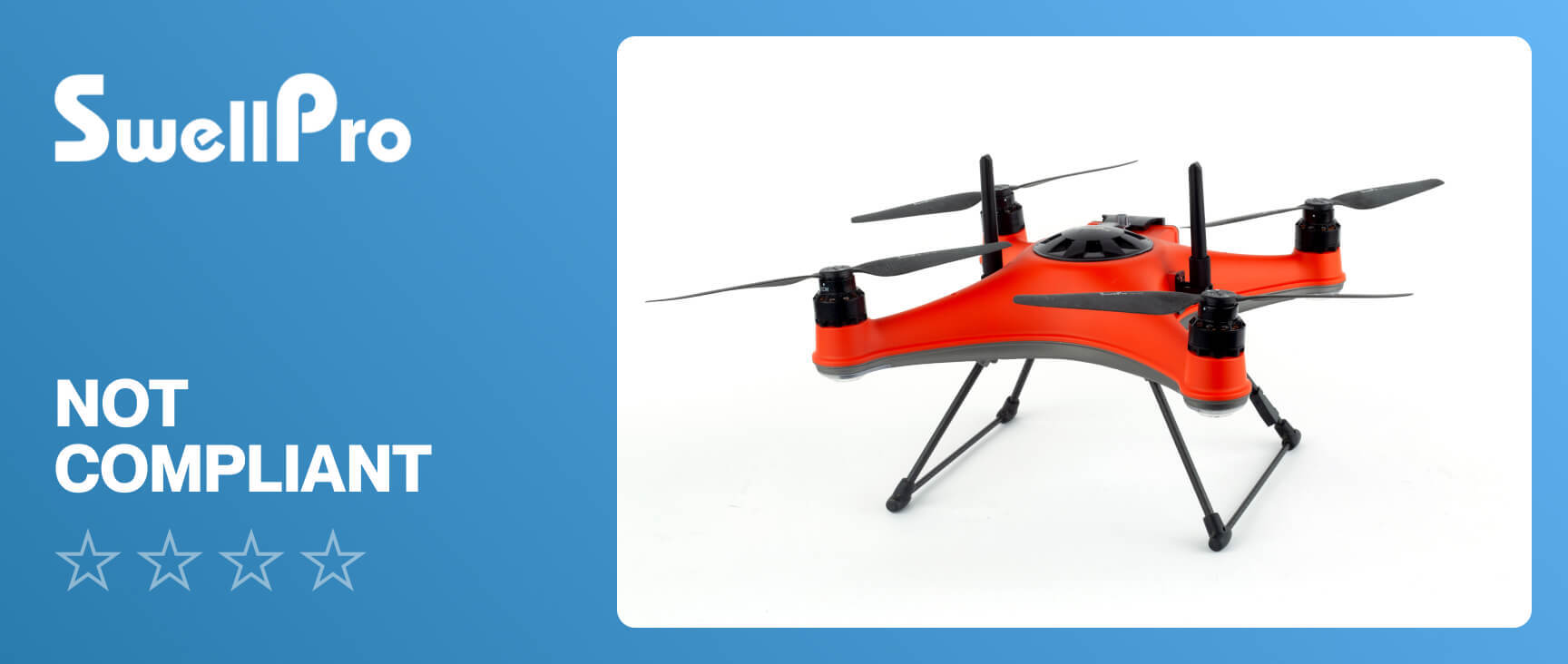
SwellPro: Not Compliant
It does not appear that SwellPro will meet the FAA deadline. There is no evidence of any Remote ID support in any of their drones as of February 2024. The SwellPro web site claims support will be ready by March 20241, but includes no additional information on implementation. The wording of their previous messages on this topic make it sound as if they plan to either partner with a company that makes a Remote ID add-on module, or just recommend customers purchase a particular module.
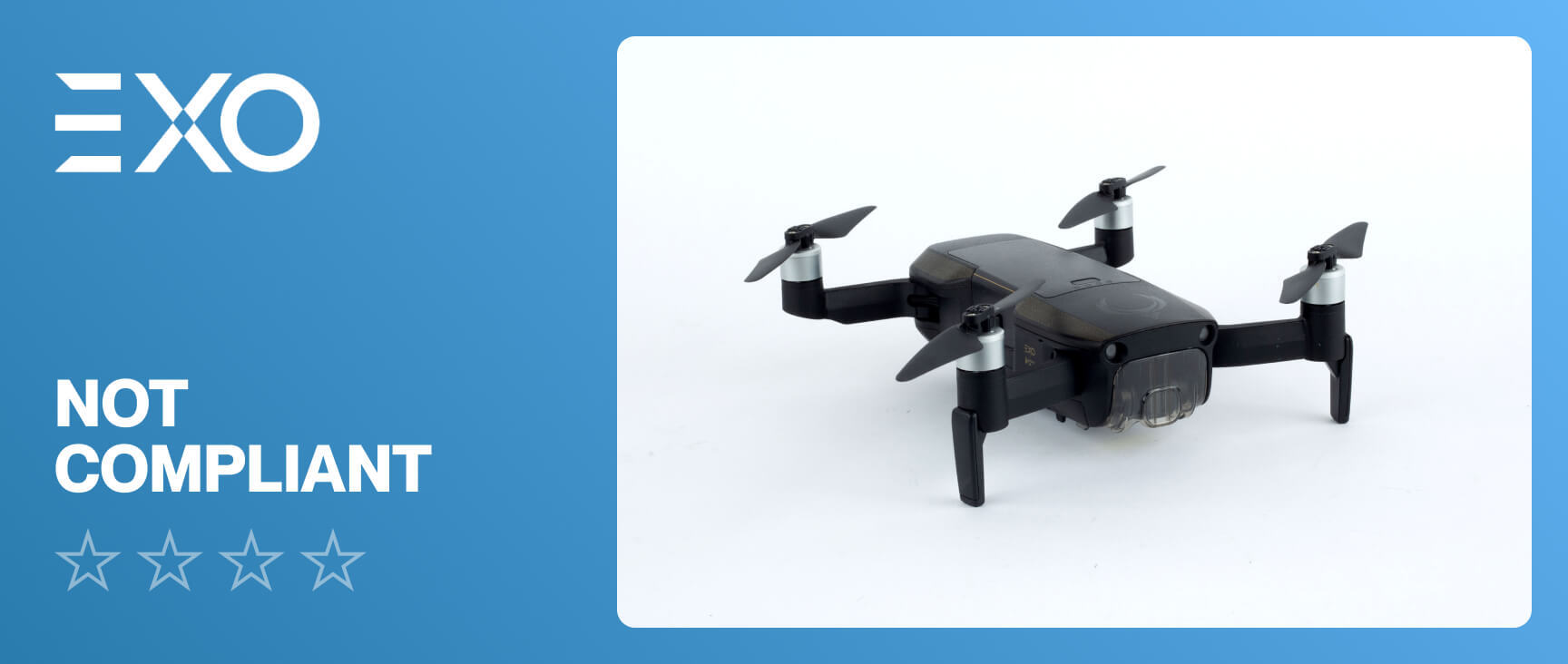
EXO: Not Compliant
EXO drones appear to be marketed as made by a U.S.-based company when they are, in fact, rebranded Hubsan drones. The EXO line has three drones listed on the FAA DoC web site, one of which includes the EXO X7 Ranger Plus. The X7 Ranger Plus obtained by the SkySafe team had no Remote ID (or for that matter, FCC) compliance markings or serial numbers anywhere on the product packaging, exterior, or controller, and no Remote ID Beacons, NaN frames, or Bluetooth Low Energy (BLE) emissions were detected.
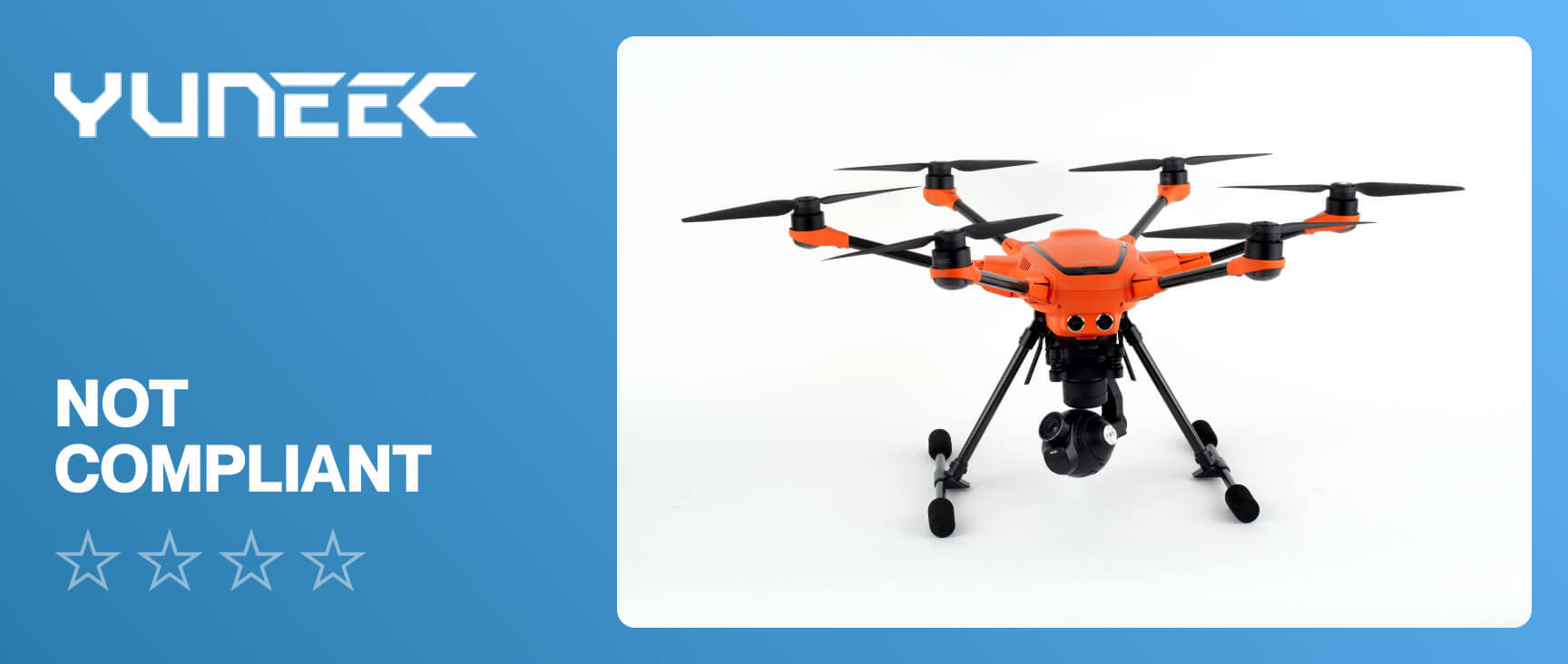
Yuneec: Not Compliant
Chinese drone manufacturer, Yuneec, announced in 2021 that its H520 model would "be upgradable through a software update making use of its WiFi radio to comply with the FAA Remote ID rules released earlier this year. The H520E and H520E-RTK will also have a software update and require a module added to its radio which will be field upgradeable."2 It appears that Yuneec changed course from its plans to offer standard Remote ID drones and, as such, has not released any firmware updates for its H520 model since late 2020. In October of 2022, Yuneec announced a partnership with Czech Remote ID module creator, Dronetag. The Dronetag Mini and Dronetag Beacon, specifically, have been approved by the Yuneec Certified Accessory Program (YCAP).3
Conclusion
Remote ID is further-complicated by the fact that there is no mechanism for authenticating the data that is being transmitted over the air. This opens the door for Remote ID spoofing like this GitHub project, RemoteIDSpoofer, which can give the appearance of multiple drones "in the air" when there are no drones in the airspace.
The array of flawed Remote ID implementations in standard Remote ID drones and the lack of data authentication mechanisms raises the question of culpability. Who is at fault if a pilot is found to be operating a standard Remote ID drone that does not adhere to the required specifications? Who will hold manufacturers responsible for implementations that do not, in fact, comply with the ASTM standard for Remote ID? What happens if a pilot's Remote ID data is spoofed to make it look as though their associated aircraft is flying in a restricted area when it is not, in fact, flying at all?
With the Remote ID deadline approaching, SkySafe's in-depth research on this topic aims to shed light on the need for accountability in adhering to standards. To that end, SkySafe will be sharing Remote ID data with the FAA to help them monitor the program well beyond the March 16 deadline.
Vendors need to revisit their efforts around Remote ID implementation to rectify these shortcomings and ensure pilots can operate their drones in a safe and compliant manner. SkySafe is happy to support drone manufacturers in these efforts by providing them with any data or analysis that may help them resolve these issues.
We are all in this together. We all want a safe and prosperous environment to operate. Embracing a culture of responsiveness around industry standards ensures safeguarding of both innovation and safety in the ever-evolving landscape of sUAS technology.
1 https://store.swellpro.com/pages/swellpros-response-to-faa-remote-id-rule
2 https://yuneec.online/faa-remote-id-h520-and-h520e-compliance/
3 https://dronetag.cz/news/2022/10/10/dronetag-yuneec-coop/
